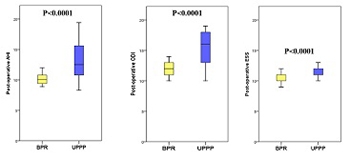Uvulopalatopharyngoplasty and barbed reposition pharyngoplasty with and without hyoid suspension for obstructive sleep apnea hypopnea syndrome: A comparison of long-term functional results
DOI:
https://doi.org/10.17305/bjbms.2020.4724Keywords:
Obstructive sleep apnea hypopnea syndrome, uvulopalatopharyngoplasty, barbed reposition pharyngoplasty, surgeryAbstract
Obstructive sleep apnea hypopnea syndrome (OSAHS) is a common condition; when conservative approaches are not effective, surgical techniques aimed at reducing the airway obstruction effect are used. This retrospective study aimed at comparing the functional outcomes in patients with OSAHS undergoing uvulopalatopharyngoplasty (UPPP) according to Fairbanks and barbed reposition pharyngoplasty (BRP) according to Mantovani, with or without hyoid suspension (HS). One-hundred twenty-two consecutive OSAHS patients who underwent surgical treatment were included in the study. Patients were divided into 4 groups; all patients underwent preoperative and postoperative polysomnography (PSG) with apnea/hypopnea index (AHI) and oxygen desaturation index (ODI) evaluation, and Epworth Sleepiness Scale (ESS) evaluation. The results were analyzed according to the different surgical procedures in relation to the preoperative PSG and anthropometric data. A significant reduction was observed at 18-month follow-up for patients in BRP group for body mass index (p = 0.004), ESS (p < 0.0001), ODI (p < 0.0001), and AHI (p < 0.0001). Risk factors for poor postoperative AHI reduction were evaluated; preoperative AHI was the strongest independent protective factor, while preoperative ODI was the strongest risk factor. The association of HS with UPPP or BRP showed significant results in terms of higher postoperative AHI reduction only when associated to UPPP (p < 0.0001). This study showed that the BRP technique was more effective compared to UPPP for patients with OSAHS. The association of HS showed greater benefits in UPPP compared to BRP. Randomized prospective trials with longer follow-up are necessary to confirm our results and formulate a more accurate indication of the optimal therapeutic strategy.
Citations
Downloads

Downloads
Additional Files
Published
Issue
Section
Categories
How to Cite
Accepted 2020-04-26
Published 2021-06-01









